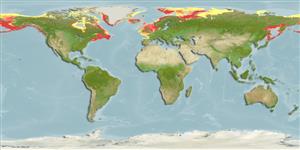Common names from other countries
Classification / Names / Names
Nomi Comuni | Sinonimi | Catalog of Fishes (gen., sp.) | ITIS | CoL | WoRMS
Environment: milieu / climate zone / depth range / distribution range
Ecologia
; distribuzione batimetrica 4 - 250 m (Ref. 3710), usually 40 - 100 m (Ref. 106788). Polar; ? - 15°C (Ref. 3706), preferred 10°C (Ref. 107945); 82°N - 32°N, 180°W - 180°E
Atlantic Ocean, Pacific and the Arctic: UK and Canadian Arctic Archipelago, Alaska to USA and Japan. Subtropical to polar.
Length at first maturity / Size / Peso / Age
Maturity: Lm ? range ? - ? cm Max length : 11.0 cm SHL maschio/sesso non determinato; (Ref. 78075); Età massima riportata: 23 anni (Ref. 8702)
Life cycle and mating behavior
Maturità | Riproduzione | Deposizione | Uova | Fecundity | Larve
Members of the class Bivalvia are mostly gonochoric, some are protandric hermaphrodites. Life cycle: Embryos develop into free-swimming trocophore larvae, succeeded by the bivalve veliger, resembling a miniature clam.
Wiborg, K.F. 1963. (Ref. 3710)
IUCN Red List Status (Ref. 130435)
CITES status (Ref. 108899)
Not Evaluated
Not Evaluated
Human uses
Pesca: commerciale
FAO - pesca: landings | FishSource | Sea Around Us
Strumenti
Fonti Internet
Estimates based on models
Preferred temperature
(Ref.
115969): 3.1 - 14.8, mean 10 (based on 1007 cells).
Resilienza
Basso, tempo minimo di raddoppiamento della popolazione 4.5 - 14 anni (K=0.14; tmax=23).
Vulnerability
Moderate to high vulnerability (47 of 100).
